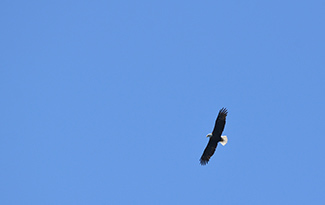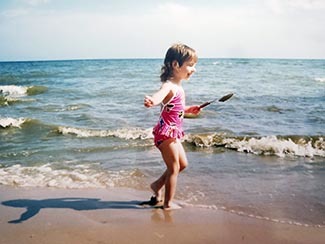|
By RACHEL COALE
Michigan Department of Natural Resources
My coworker Kathleen says she remembers when there were no fireflies.
For me, it’s hard to imagine a hazy summer night without them floating luminously in the tall grass, winking out and reappearing as if powered by magic.
The thought of them going missing is unsettling. But researchers say that’s what is happening, pointing to light pollution, pesticides and habitat loss as drivers of the trend.
It’s easy to talk about the big events in environmental history: rivers aflame, piles of trash swirling in the ocean and oil spills blotting out rivers. But who would notice the absence of a fleeting glow on a warm summer night?
An eye for detail led Kathleen to her first career as a journalist, seeking the truth and finding the core of a story. She tells colorful stories of her experiences, weaving sights and sounds into words.

“Showing the details…turns a summary into a movie,” she has said.
A familiar anecdote from Kathleen is about the missing fireflies of her youth.
Unlike in my childhood, she didn’t have them in her neighborhood – they were just gone. The fireflies were likely the casualties of a since-discontinued pesticide spraying program, common at the time, that wiped out the good bugs with the bad.
Most of us know about the plight, and subsequent comeback story, of America’s bald eagles. With their eggshells weakened by the pesticide DDT, nests failed, and the species was in peril. At their lowest point in the late 1970s, there were only about 400 surviving eagle pairs in the lower 48 states. They’ve since recovered their place in the sky after a national ban on the pesticide and regulations enacted to protect eaglets.
But what about the smaller things, like fireflies?
At least in Kathleen’s neighborhood, she’s been able to spot the glow of fireflies where there weren’t any years before.
|

In my case, I grew up in northern Lower Michigan, after bottle deposits, the Clean Air and Water acts of the 1970s and people’s demand for a cleaner world changed the landscape.
Things aren’t perfect; I still sometimes come across a dump site in the forest when I’m hiking. But for the most part, our woods and waters are much cleaner than they once were.
Growing up, my siblings and I caught fireflies in old jam jars, marveling at their blinking, greenish glow (the product of a chemical reaction). I was never afraid to proudly bring home and cook a bluegill I’d caught on a family fishing trip, or breathe in the night air on a campout and worry that there was anything in it other than the scent of dew and fresh grass.
Not that long ago, that wasn’t the case in many places. A lot of thought and effort has gone into making our actions less harmful to the ecosystem. While we’ve made progress, there is still more to do.
Today’s environmental issues remain challenging and vitally important, but perhaps not always as visible.
For the most part, you can’t see or smell contaminants like per- and polyfluoroalkyl substances (PFAS) – a suite of manmade chemicals found in a wide range of items from nonstick cookware to weather-resistant clothing and fire retardants – or know how much carbon is in the atmosphere just by looking.
|

Working for the Michigan Department of Natural Resources, I have gained firsthand perspective on the ways my coworkers within the department, in our sister agency, the Michigan Department of Environment, Great Lakes and Environment, and people across the state who love the outdoors are continuing to work to keep natural resources healthy.
They are connecting with nature and taking steps to protect our interconnected ecosystems from threats like pollution and invasive species.
It doesn’t mean that we all must start exclusively wearing hemp and shunning deodorant, as stereotypes would have us believe. It just means being mindful, making smart choices and thinking about our connections with nature. To paraphrase poet and activist Maya Angelou, “when we know better, we do better.”
As hikers, hunters, anglers, birders and outdoorspeople of all kinds, we’re the ambassadors for outdoor spaces with the ability to share why these places matter. We can help ensure that kids can be captivated by nature’s magic, like fireflies, for generations to come.
What will I be able to tell people 30 years from now?
Like the spark of a firefly, I hope we invite nature to quietly wink into our lives.
|
Check out previous Showcasing the DNR stories in our archive at Michigan.gov/DNRStories. To subscribe to upcoming Showcasing articles, sign up for free email delivery at Michigan.gov/DNR.
/Note to editors: Contact: John Pepin, Showcasing the DNR series editor, 906-226-1352. Accompanying photos and a text-only version of this story are available below for download. Caption information follows. Credit Michigan Department of Natural Resources, unless otherwise noted.
Text-only Showcasing - Fireflies
Beach: A young Rachel Coale, author of this story, enjoying and interacting with the Great Lakes. (Rachel Coale photo)
Eagle: Bald eagles have made a dramatic return from a low population level of about 400 pairs remaining in the lower 48 states in the early 1970s.
Fireflies: A nighttime photo shows the glow of fireflies displaying in flight. (Shutterstock image)
Grass: A photo of author Rachel Coale, as a young girl, experiencing her first time in the grass. (Rachel Coale photo)
Hawkweed: The beauty of nature is all around us, filled with things to enjoy, like this blooming red hawkweed photographed in Marquette County.
Kayak: A mother and child enjoy interacting with nature on an afternoon paddle and fishing excursion on Lake Fanny Hooe at Fort Wilkins Historic State Park in Keweenaw County.
Monarchs: Small creatures, like these monarch butterflies photographed in Delta County, are as important to our ecosystems as larger, more high-profile, animals like white-tailed deer and bears.
Water: Cleaner water is one positive result of environmental activism initiated during the 1960s and 1970s. Lake Superior is shown here in an image from F.J. McLain State Park in Houghton County./
|